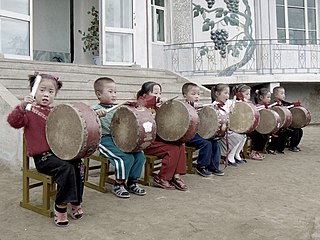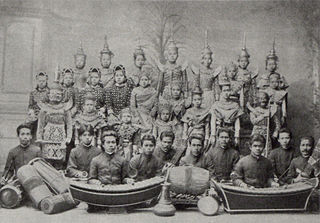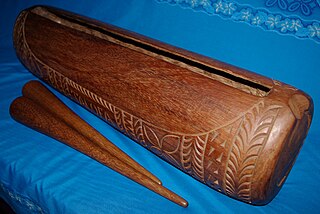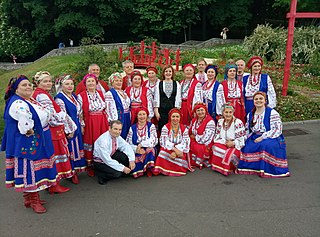Related Research Articles
A carol is a festive song, generally religious but not necessarily connected with Christian church worship, and sometimes accompanied by a dance. A caroller is someone who sings carols, and is said to be carolling.

The music of North Korea includes a wide array of folk, hip-hop, light instrumental, political, and classical performers. Beyond patriotic and political music, popular groups like Pochonbo Electronic Ensemble and Moranbong Band perform songs about everyday life in the DPRK and modern light pop reinterpretations of classic Korean folk music. Music education is widely taught in schools, with President Kim Il Sung first implementing a program of study of musical instruments in 1949 at an orphanage in Mangyongdae. Musical diplomacy also continues to be relevant to the Democratic People's Republic of Korea, with musical and cultural delegations completing concerts in China and France in recent years, and musicians from Western countries and South Korea collaborating on projects in the DPRK.
The music of Sri Lanka has its roots in five primary influences: ancient folk rituals, Hindu religious traditions, Buddhist religious traditions, the legacy of European colonisation, and the commercial and historical influence of nearby Indian culture—specifically, Kollywood cinema and Bollywood cinema.

The music of Thailand reflects its geographic position at the intersection of China and India, as well as historical trade routes including with Africa, Greece and Rome.

John Milford Rutter is an English composer, conductor, editor, arranger, and record producer, mainly of choral music.
Traditional Māori music, or pūoro Māori, is composed or performed by Māori, the indigenous people of New Zealand, and includes a wide variety of folk music styles, often integrated with poetry and dance.

The traditional music of Tuvalu consists of dances, including fatele, fakanau and fakaseasea. The influence of the Samoan missionaries sent to Tuvalu by the London Missionary Society from the 1860s resulted in the suppression of songs about the traditional religions or magic and many songs were lost. As the influence of the missionaries diminished in the 20th century the traditional dances were revived and the siva dance tradition from Samoa also became popular.

The music of Tokelau occurs in the atolls of Atafu, Nukunonu, and Fakaofo. It is dominated by communal choral activity in harmony, with percussive accompaniment including log drums (pate), pokihi and apa. Nukunonu is notable for traditional song and dance.
The music of the Northern Mariana Islands is dominated by the folk music of the Chamorros, which remains an important part of the islands' culture, though elements of music left by American, German, Spanish and Japanese colonizers are also in evidence. There are both Carolinian and Chamorro traditional chant styles. A variant of the Spanish cha-cha-chá is popular, as is a Carolinian "stick dance" which combines improvised percussion and foot stomping. A well-known stick dance group is the Talabwog Men Stick Dancers.

Dappankuthu is a folk dance and music genre with an emphasis on percussion performed in the South Indian state of Tamil Nadu. It is one of several popular genres employed in film music, mainly in Tamil cinema and other South films, filmed and produced by people of Tamil culture. It has been imported to Telugu culture and cinema under the Telugu name teenmaar.
Dene music is music composed by Northern Athabaskan-speaking First Nations peoples - the Chipewyan (Denesuline), Tlicho (Dogrib), Yellowknives (T'atsaot'ine), Slavey, and Sahtu. The term generally refers to traditional musical compositions and dances.
Chen Yi is a Chinese-American composer of contemporary classical music and violinist. She was the first Chinese woman to receive a Master of Arts (M.A.) in music composition from the Central Conservatory of Music in Beijing. Chen was a finalist for the 2006 Pulitzer Prize for Music for her composition Si Ji, and has received awards from the Koussevistky Music Foundation and American Academy of Arts and Letters, as well as fellowships from the Guggenheim Foundation and the National Endowment for the Arts. In 2010, she was awarded an Honorary Doctorate from The New School and in 2012, she was awarded the Brock Commission from the American Choral Directors Association. She was elected to the American Academy of Arts and Letters in 2019.

Dance in Kiribati includes various styles unique to the island nation. The uniqueness of Kiribati dance when compared with other forms of Pacific Islands dance is its emphasis on the outstretched arms of the dancer and the sudden birdlike movement of the head. The Frigate bird on the Kiribati flag refers to this bird-like style of Kiribati dancing. Most dances are in the standing or sitting position with movement limited and staggered.
Alice Shields is an American classical composer. She is one of the pioneers of electronic music, and is particularly known for her cross-cultural operas.
Contemporary Kiribati culture is centered on the family, the church and the sea.
Ofer Ben-Amots is an Israeli-American composer and teacher of music composition and theory at Colorado College. His music is inspired by Jewish folklore of Eastern-European Yiddish and Judeo-Spanish Ladino traditions. The interweaving of folk elements with contemporary textures creates the dynamic tension that permeates and defines Ben-Amots' musical language.

Ukrainian folk music includes a number of varieties of traditional, folkloric, folk-inspired popular music, and folk-inspired European classical music traditions.
A fakanau is a traditional Tuvaluan male dance, accompanied by singing and rhythmic clapping.
Gerd Koch was a German cultural anthropologist best known for his studies on the material culture of Kiribati, Tuvalu and the Santa Cruz Islands in the Pacific. He was associated with the Ethnological Museum of Berlin. His field work was directed to researching and recording the use of artefacts in their indigenous context, to begin to understand these societies.

The fatele or faatele is a traditional dance song of Tuvalu. Dancing songs are the most common type of traditional Tuvaluan song, with other traditional dance styles including fakanau and fakaseasea.
References
- 1 2 "Music from Kiribati". Encarta. Archived from the original on 2009-08-29. Retrieved September 29, 2005.
- ↑ "Kiribati". National Anthem Reference Page. Retrieved September 29, 2005.
- 1 2 3 "Traditional Kiribati Music". Jane's Oceania Page. Retrieved September 29, 2005.
- ↑ "IWF Wissen und Medien". Film Archives Online. Retrieved 5 February 2014.
- ↑ "70 Silent Films by Gerd Koch from the Gilbert Islands". Göttingen University.
- ↑ "Country profile: Kiribati", The Guardian, April 22, 2009